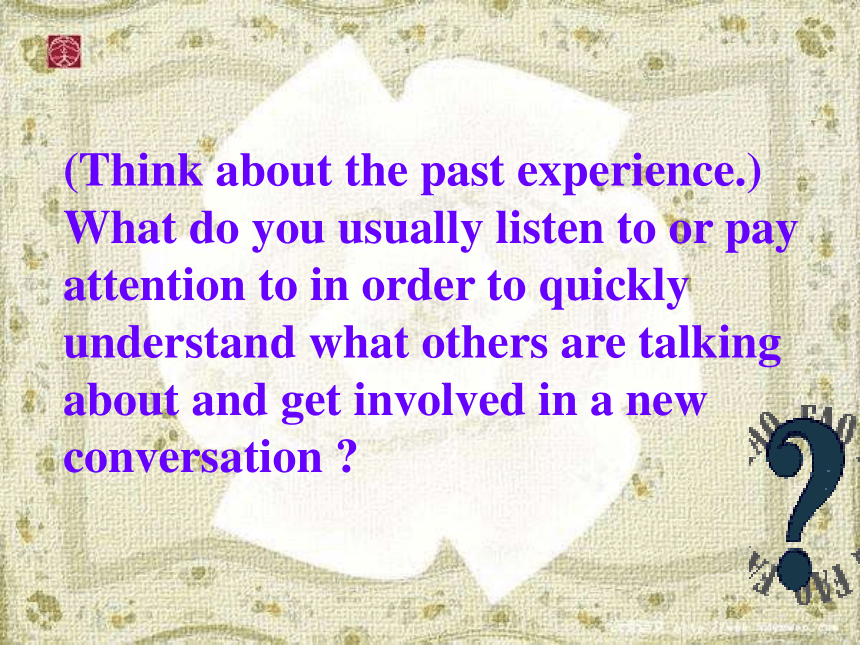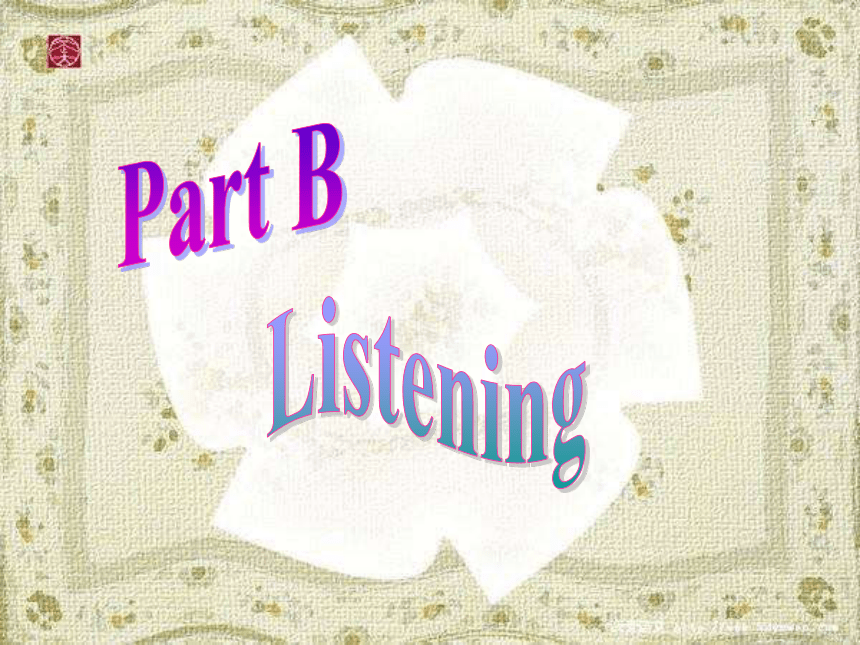2014高中英语 Module 3 Unit3Back to the past课件 译林牛津版必修3
文档属性
| 名称 | 2014高中英语 Module 3 Unit3Back to the past课件 译林牛津版必修3 |  | |
| 格式 | zip | ||
| 文件大小 | 5.9MB | ||
| 资源类型 | 教案 | ||
| 版本资源 | 牛津译林版 | ||
| 科目 | 英语 | ||
| 更新时间 | 2014-07-23 17:23:41 | ||
图片预览












文档简介
课件44张PPT。 Unit 3 Back to the pastTask
GIVING A TALK ABOUT A HISTORICAL EVENTSkills building 1listening for the gist You have conversations with your friends, your relatives and other people every day.
1. What decides the topic you are talking
about?
2. Will the topic be different if someone
else joins your conversation?
3. Will the topic be different if you move
to another place to talk?
4. Will it be different if you are doing
something else while you are talking? (Think about the past experience.)
What do you usually listen to or pay attention to in order to quickly understand what others are talking about and get involved in a new conversation ?
When we are listening to get the gist of something, we are listening for the general idea.
We usually try to find out about:how many people are talkingwhere they arewhat they are doingwhat they are talking aboutListening:The number of people talking:
The place they are talking in:
The thing they are doing while talking:
The subject they are talking about:threetaking noteslearning from past experiencesclassroomStep 1finding useful expressionsHave you ever given a talk?
If you have, where did you do it?
What was your topic?
What did you say at the beginning and at the end of your talk?
Did you ask someone for suggestions before the talk?Part AListening
Note Sheet
I am now listening to (1) a quarrel/an interview/a chat between friends.
I can hear (2) one person / two people / three people talking.
The conversation takes place in a (3) classroom / restaurant / library.
The title of the girl’s talk is (4)The surprise attack .____________________
_____________________Part BListeningUseful expressions to use when giving a talk
1 Greeting the audience
Informal:
(1)
Hello, good to see you all here.
Nice to see you all here.
Formal:
Welcome, ladies and gentlemen.
Good morning, ladies and gentlemen.Good morning, everyone.2 Expressing thanks to the audience
Informal:
Thanks for coming. I'm so glad you could all join us.
Thank you for coming to the talk today.
Formal:
Thank you all for taking the time to be here.
(2)
Thank you for joining us, ladies and gentlemen.I’m very grateful that you have come today.3 Explaining the reason why you are talking to the audience
Today (3) show you some illustrations of the Attack on Pearl Harbor, and to tell you something about
(4) and what its
consequences were.
We're all gathered here to view some ...I am here tohow it happened4 Mentioning your hopes
I hope this has been informative and interesting for you.
(5)
Hopefully you have all learned something new.I hope that you enjoyed this talk.5 Giving a final expression of thanks
Thank you for being such a good audience.
(6)
Thanks again for coming.Thank you for your kind attention. 6 Giving the audience a question-and-answer session
I'm now open for any questions you may have.
(7)
Now that we're finished, does anyone have any questions?If you have any questions, please feel free to ask me.Skills building 2describing illustrationsWhen we are describing an illustration, we do not wish to point out every detail of it. The audience will not be interested in something they can see for themselves. They are more interested in things that are related to the illustration in a significant way. Therefore, when we are describing an illustration, we may briefly mention the subject of the illustration first, and then focus on the related background information about the illustration.Look at the picture and try to
say something about it.the Mogao Caves Sample illustration:
This is a cave painting in the 112th cave of the Mogao Caves. The caves are located in Dunhuang, Gansu Province, on the famous Silk Road.Look at these pictures and try to give the related background information about the illustration. Key words:
Tian'anmen Gate
1st October 1949
the founding ceremony of the People's Republic of China
Chairman Mao ZedongSample
This is a picture of Tian’anmen Gate. On 1st October, 1949, the founding ceremony of the People’s Republic of China was held on the second floor of Tian’anmen Gate. Chairman Mao announced the founding of the new country as he overlooked Tian’anmen Square. The Tower bridge in LondonAngkor wat. writing descriptions for your illustrationsStep 2 You are preparing for your talk about the Attack on Pearl Harbor. Below is the information you have found on a website. Use it to describe the illustrations you have. Write your descriptions on a piece of paper.
http://www.PearlHarborAttack.com
Pearl Harbor, part of the Hawaiian Islands, is one of the major military bases of the United States. A surprise attack was carried out there by the Japanese in 1941. The attack led to the US coming into the Second World War.
On 26th November 1941, 39 Japanese ships set sail for the Hawaiian Islands. On 7th December, they attacked the US airfields and the US ships in Pearl Harbor.
At around 8.10 a.m., the United States Ship (USS) Arizona was heavily bombed and eventually exploded. In less than 9 minutes, the ship sank with 1,177 men on
board. The USS Oklahoma was also hit with more than 400 men inside.
Many other American ships were sunk or badly damaged. Almost 200 American airplanes were destroyed and about 3,000 American soldiers were killed or wounded in just a few hours.
The next day, US President Franklin Roosevelt declared war against Japan.
In memory of the Americans who died in the attack, a national memorial was built in Pearl Harbor just above the remains of the sunken battleship Arizona.
next pageSample answers
These photos remind us of the attack carried out in 1941 by the Japanese on Pearl Harbor, an important US military base in Hawaii, during World War II.1. This picture shows the night before the attack. Many Japanese ships and aircraft carriers sailed to the Hawaiian Islands and were waiting there for a surprise attack.2. This picture shows the scene after the attack. As a result of the fatal attack, much of the US Pacific Fleet was destroy. 3. The man in this picture is the former US President Franklin Roosevelt. He declared the war against Japan after the attack.4. This picture shows the US national memorial at Pearl Harbor. It was established to remember those Americans who died in the attack in 1941.planning an outline for a speech Skills building 3 A simple speech outline often includes seven parts: 1. a greeting to the audience
2. an expression of thanks to the audience
3. an explanation of the aim or the topic
4. the main body of the speech
5. hopes for the future
6. the conclusion of the speech
7. a final expression of thanks Read the instructions in this part. You must be sure to understand each point.
Consider the following questions with your partners:
1. When you prepare a speech, what should you first think about?
2. Will you do anything to interest your
audience?
3. How and what will you do then? How do
you start your speech?
4. What do you say to greet your guests?
5. How do you finish your speech?Read the instructions for the exercise on page 56 and organize the notes into an outline for a speech. Future: UNESCO is going to help protect more sites around the world and provide more education to make sure that people can enjoy the treasures from the past.
Good afternoon, distinguished guests.
Explanation: what UNESCO has done to protect the world cultural heritage.
Thank you for your kind attention.
I am very honoured and grateful that you have come today.
Join us and support our project of protecting the world cultural heritage.
What our team has done in Lijiang, Yunnan Province, China: helping local people form an action plan to preserve the ancient town, move most factories out of town, improve the water supply and fire control.giving your talk Step 3Part A
Before you give your talk, plan an outline for it to introduce your illustrations. Look at what you have done in Steps 1 and 2. Write down your outline below.Part B
Give your talk in your group.Thank you!
GIVING A TALK ABOUT A HISTORICAL EVENTSkills building 1listening for the gist You have conversations with your friends, your relatives and other people every day.
1. What decides the topic you are talking
about?
2. Will the topic be different if someone
else joins your conversation?
3. Will the topic be different if you move
to another place to talk?
4. Will it be different if you are doing
something else while you are talking? (Think about the past experience.)
What do you usually listen to or pay attention to in order to quickly understand what others are talking about and get involved in a new conversation ?
When we are listening to get the gist of something, we are listening for the general idea.
We usually try to find out about:how many people are talkingwhere they arewhat they are doingwhat they are talking aboutListening:The number of people talking:
The place they are talking in:
The thing they are doing while talking:
The subject they are talking about:threetaking noteslearning from past experiencesclassroomStep 1finding useful expressionsHave you ever given a talk?
If you have, where did you do it?
What was your topic?
What did you say at the beginning and at the end of your talk?
Did you ask someone for suggestions before the talk?Part AListening
Note Sheet
I am now listening to (1) a quarrel/an interview/a chat between friends.
I can hear (2) one person / two people / three people talking.
The conversation takes place in a (3) classroom / restaurant / library.
The title of the girl’s talk is (4)The surprise attack .____________________
_____________________Part BListeningUseful expressions to use when giving a talk
1 Greeting the audience
Informal:
(1)
Hello, good to see you all here.
Nice to see you all here.
Formal:
Welcome, ladies and gentlemen.
Good morning, ladies and gentlemen.Good morning, everyone.2 Expressing thanks to the audience
Informal:
Thanks for coming. I'm so glad you could all join us.
Thank you for coming to the talk today.
Formal:
Thank you all for taking the time to be here.
(2)
Thank you for joining us, ladies and gentlemen.I’m very grateful that you have come today.3 Explaining the reason why you are talking to the audience
Today (3) show you some illustrations of the Attack on Pearl Harbor, and to tell you something about
(4) and what its
consequences were.
We're all gathered here to view some ...I am here tohow it happened4 Mentioning your hopes
I hope this has been informative and interesting for you.
(5)
Hopefully you have all learned something new.I hope that you enjoyed this talk.5 Giving a final expression of thanks
Thank you for being such a good audience.
(6)
Thanks again for coming.Thank you for your kind attention. 6 Giving the audience a question-and-answer session
I'm now open for any questions you may have.
(7)
Now that we're finished, does anyone have any questions?If you have any questions, please feel free to ask me.Skills building 2describing illustrationsWhen we are describing an illustration, we do not wish to point out every detail of it. The audience will not be interested in something they can see for themselves. They are more interested in things that are related to the illustration in a significant way. Therefore, when we are describing an illustration, we may briefly mention the subject of the illustration first, and then focus on the related background information about the illustration.Look at the picture and try to
say something about it.the Mogao Caves Sample illustration:
This is a cave painting in the 112th cave of the Mogao Caves. The caves are located in Dunhuang, Gansu Province, on the famous Silk Road.Look at these pictures and try to give the related background information about the illustration. Key words:
Tian'anmen Gate
1st October 1949
the founding ceremony of the People's Republic of China
Chairman Mao ZedongSample
This is a picture of Tian’anmen Gate. On 1st October, 1949, the founding ceremony of the People’s Republic of China was held on the second floor of Tian’anmen Gate. Chairman Mao announced the founding of the new country as he overlooked Tian’anmen Square. The Tower bridge in LondonAngkor wat. writing descriptions for your illustrationsStep 2 You are preparing for your talk about the Attack on Pearl Harbor. Below is the information you have found on a website. Use it to describe the illustrations you have. Write your descriptions on a piece of paper.
http://www.PearlHarborAttack.com
Pearl Harbor, part of the Hawaiian Islands, is one of the major military bases of the United States. A surprise attack was carried out there by the Japanese in 1941. The attack led to the US coming into the Second World War.
On 26th November 1941, 39 Japanese ships set sail for the Hawaiian Islands. On 7th December, they attacked the US airfields and the US ships in Pearl Harbor.
At around 8.10 a.m., the United States Ship (USS) Arizona was heavily bombed and eventually exploded. In less than 9 minutes, the ship sank with 1,177 men on
board. The USS Oklahoma was also hit with more than 400 men inside.
Many other American ships were sunk or badly damaged. Almost 200 American airplanes were destroyed and about 3,000 American soldiers were killed or wounded in just a few hours.
The next day, US President Franklin Roosevelt declared war against Japan.
In memory of the Americans who died in the attack, a national memorial was built in Pearl Harbor just above the remains of the sunken battleship Arizona.
next pageSample answers
These photos remind us of the attack carried out in 1941 by the Japanese on Pearl Harbor, an important US military base in Hawaii, during World War II.1. This picture shows the night before the attack. Many Japanese ships and aircraft carriers sailed to the Hawaiian Islands and were waiting there for a surprise attack.2. This picture shows the scene after the attack. As a result of the fatal attack, much of the US Pacific Fleet was destroy. 3. The man in this picture is the former US President Franklin Roosevelt. He declared the war against Japan after the attack.4. This picture shows the US national memorial at Pearl Harbor. It was established to remember those Americans who died in the attack in 1941.planning an outline for a speech Skills building 3 A simple speech outline often includes seven parts: 1. a greeting to the audience
2. an expression of thanks to the audience
3. an explanation of the aim or the topic
4. the main body of the speech
5. hopes for the future
6. the conclusion of the speech
7. a final expression of thanks Read the instructions in this part. You must be sure to understand each point.
Consider the following questions with your partners:
1. When you prepare a speech, what should you first think about?
2. Will you do anything to interest your
audience?
3. How and what will you do then? How do
you start your speech?
4. What do you say to greet your guests?
5. How do you finish your speech?Read the instructions for the exercise on page 56 and organize the notes into an outline for a speech. Future: UNESCO is going to help protect more sites around the world and provide more education to make sure that people can enjoy the treasures from the past.
Good afternoon, distinguished guests.
Explanation: what UNESCO has done to protect the world cultural heritage.
Thank you for your kind attention.
I am very honoured and grateful that you have come today.
Join us and support our project of protecting the world cultural heritage.
What our team has done in Lijiang, Yunnan Province, China: helping local people form an action plan to preserve the ancient town, move most factories out of town, improve the water supply and fire control.giving your talk Step 3Part A
Before you give your talk, plan an outline for it to introduce your illustrations. Look at what you have done in Steps 1 and 2. Write down your outline below.Part B
Give your talk in your group.Thank you!
